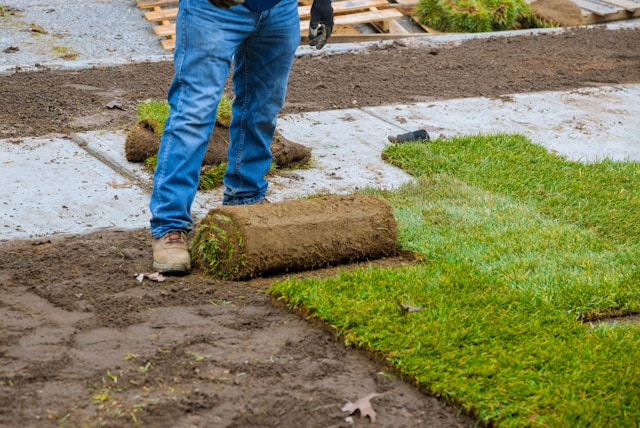Types of grass suitable for sodding

Sodding, the process of installing pre-grown grass turf, offers a quick and effective solution for establishing lush green lawns and landscapes. However, the success of sod installation greatly depends on selecting the right type of grass that suits the local climate, soil conditions, and intended use of the lawn. In this comprehensive guide, we’ll delve into various types of grass suitable for sodding, exploring their characteristics, advantages, and ideal growing conditions.
1. Warm-Season Grasses:
Warm-season grasses thrive in hot climates and are ideal for regions with long, sunny summers and mild winters. They exhibit peak growth during the warmer months and often go dormant in winter. Here are some popular warm-season grasses used for sodding:
a. Bermuda Grass (Cynodon dactylon):
- Characteristics: Bermuda grass is known for its fine texture, dense growth, and excellent tolerance to heat, drought, and foot traffic. It forms a lush, green carpet and recovers quickly from damage.
- Advantages: Rapid establishment, high wear resistance, and low water requirements make Bermuda grass a top choice for sports fields, golf courses, and high-traffic areas.
- Ideal Growing Conditions: Full sun, well-drained soil, and warm temperatures (60-90°F).
b. Zoysia Grass (Zoysia spp.):
- Characteristics: Zoysia grass exhibits a dense, luxurious turf with a medium to fine texture. It offers good tolerance to heat, drought, and shade, along with excellent wear resistance.
- Advantages: Zoysia grass requires minimal maintenance, displays excellent weed resistance, and performs well in both residential and commercial landscapes.
- Ideal Growing Conditions: Full sun to partial shade, well-drained soil, and warm temperatures (60-80°F).
c. Centipede Grass (Eremochloa ophiuroides):
- Characteristics: Centipede grass features a coarse texture and light green color. It forms a low-maintenance turf with moderate tolerance to heat, drought, and acidic soils.
- Advantages: Centipede grass requires less mowing and fertilization compared to other warm-season grasses. It is well-suited for low-input lawns and landscapes.
- Ideal Growing Conditions: Full sun to partial shade, well-drained soil, and warm temperatures (70-90°F).
2. Cool-Season Grasses:
Cool-season grasses thrive in regions with moderate temperatures and distinct seasons, including cool summers and cold winters. They experience peak growth in spring and fall, with reduced growth during hot summer months. Here are some common cool-season grasses suitable for sodding:
a. Kentucky Bluegrass (Poa pratensis):
- Characteristics: Kentucky bluegrass is known for its fine texture, dark green color, and dense growth habit. It forms a lush, resilient turf with good tolerance to cold temperatures and foot traffic.
- Advantages: Kentucky bluegrass produces a high-quality lawn suitable for residential lawns, parks, and athletic fields. It has excellent self-repairing capabilities and good resistance to diseases.
- Ideal Growing Conditions: Full sun to partial shade, well-drained soil, and cool temperatures (60-75°F).
b. Fescue Grass (Festuca spp.):
- Characteristics: Fescue grasses encompass various species, including tall fescue, fine fescue, and creeping fescue. They exhibit fine to coarse textures and varying shades of green.
- Advantages: Fescue grasses are valued for their shade tolerance, drought resistance, and low maintenance requirements. They thrive in cooler climates and are suitable for both sunny and shaded areas.
- Ideal Growing Conditions: Partial shade to full sun (depending on species), well-drained soil, and cool to moderate temperatures (50-75°F).
c. Perennial Ryegrass (Lolium perenne):
- Characteristics: Perennial ryegrass features a fine to medium texture and vibrant green color. It establishes quickly and forms a dense, attractive turf with good wear tolerance.
- Advantages: Perennial ryegrass is prized for its rapid germination, establishment, and ability to blend well with other grass species. It is commonly used for overseeding warm-season lawns to maintain green color during cooler months.
- Ideal Growing Conditions: Full sun to partial shade, well-drained soil, and cool temperatures (50-75°F).
3. Transition Zone Grasses:
Transition zone grasses occupy regions with fluctuating climates that experience both warm and cool temperature extremes. These grasses offer a compromise between warm-season and cool-season varieties, providing adaptability to diverse environmental conditions. Here are some transitional grasses suitable for sodding:
a. Tall Fescue (Festuca arundinacea):
- Characteristics: Tall fescue is known for its coarse texture, deep green color, and robust growth habit. It forms a durable turf with good heat and drought tolerance, along with moderate shade tolerance.
- Advantages: Tall fescue is suitable for transitional climates where both warm and cool-season grasses struggle. It performs well in areas with hot summers and cold winters, making it a versatile choice for lawns and landscapes.
- Ideal Growing Conditions: Full sun to partial shade, well-drained soil, and moderate temperatures (60-75°F).
b. Fine Fescue (Festuca rubra):
- Characteristics: Fine fescue encompasses several species, including creeping red fescue, chewings fescue, and hard fescue. They exhibit fine textures, varying shades of green, and good shade tolerance.
- Advantages: Fine fescues are well-suited for transitional climates and shady areas where other grass species struggle. They require less water and fertilizer, making them ideal for low-maintenance landscapes and eco-friendly lawn options.
- Ideal Growing Conditions: Partial shade to full sun (depending on species), well-drained soil, and cool to moderate temperatures (50-75°F).
c. Zoysia Grass (Zoysia spp.):
- Characteristics: Zoysia grasses, particularly certain cultivars like Meyer Zoysia or Zeon Zoysia, exhibit transitional characteristics suitable for regions with mild winters and hot summers. They combine the heat tolerance of warm-season grasses with the cold hardiness of cool-season varieties.
- Advantages: Transitional zone zoysia grasses offer versatility and adaptability to diverse climates, making them suitable for a wide range of applications, from residential lawns to commercial landscapes.
- Ideal Growing Conditions: Full sun to partial shade, well-drained soil, and moderate temperatures (60-80°F).
Conclusion:
Selecting the right type of grass for sodding is crucial for establishing a healthy, vibrant lawn that thrives in its environment. Whether you reside in a warm climate, a cool climate, or a transitional zone, there are numerous grass varieties available to suit your specific needs and preferences. By understanding the characteristics, advantages, and ideal growing conditions of different grass types, you can make an informed decision that ensures the long-term success and beauty of your sodded lawn or landscape.

